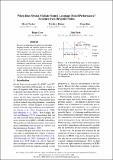| dc.contributor.author | Tucker, Mycal | |
| dc.contributor.author | Eisape, Tiwalayo | |
| dc.contributor.author | Qian, Peng | |
| dc.contributor.author | Levy, Roger | |
| dc.contributor.author | Shah, Julie | |
| dc.date.accessioned | 2023-03-30T13:36:21Z | |
| dc.date.available | 2023-03-30T13:36:21Z | |
| dc.date.issued | 2022 | |
| dc.identifier.uri | https://hdl.handle.net/1721.1/150010 | |
| dc.language.iso | en | |
| dc.publisher | Association for Computational Linguistics (ACL) | en_US |
| dc.relation.isversionof | 10.18653/V1/2022.NAACL-MAIN.394 | en_US |
| dc.rights | Article is made available in accordance with the publisher's policy and may be subject to US copyright law. Please refer to the publisher's site for terms of use. | en_US |
| dc.source | Association for Computational Linguistics | en_US |
| dc.title | When Does Syntax Mediate Neural Language Model Performance? Evidence from Dropout Probes | en_US |
| dc.type | Article | en_US |
| dc.identifier.citation | Tucker, Mycal, Eisape, Tiwalayo, Qian, Peng, Levy, Roger and Shah, Julie. 2022. "When Does Syntax Mediate Neural Language Model Performance? Evidence from Dropout Probes." Proceedings of the 2022 Conference of the North American Chapter of the Association for Computational Linguistics: Human Language Technologies. | |
| dc.contributor.department | Massachusetts Institute of Technology. Department of Brain and Cognitive Sciences | en_US |
| dc.relation.journal | Proceedings of the 2022 Conference of the North American Chapter of the Association for Computational Linguistics: Human Language Technologies | en_US |
| dc.eprint.version | Final published version | en_US |
| dc.type.uri | http://purl.org/eprint/type/ConferencePaper | en_US |
| eprint.status | http://purl.org/eprint/status/NonPeerReviewed | en_US |
| dc.date.updated | 2023-03-30T13:34:29Z | |
| dspace.orderedauthors | Tucker, M; Eisape, T; Qian, P; Levy, R; Shah, J | en_US |
| dspace.date.submission | 2023-03-30T13:34:30Z | |
| mit.license | PUBLISHER_POLICY | |
| mit.metadata.status | Authority Work and Publication Information Needed | en_US |
